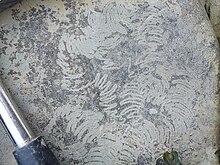Nereites is an ichnogenus of trace fossil. Modern tracemakers of incipient Nereites include worm-like organisms,[1] horseshoe crabs[2] and hermit crabs.[3] Traditionally, two models have been proposed for Nereites:
- in the ‘worm model’, Nereites is a feeding burrow produced by wormlike organisms, probing and backfilling laterally[1]
- in the ‘arthropod model’, the characteristic lobes are pressure-release structures made by arthropod legs. According to this interpretation, Nereites is a locomotion trail[2]
| Nereites Temporal range: (perhaps earlier, references needed)
| |
|---|---|

| |
| Nereites irregularis | |
| Trace fossil classification | |
| Ichnogenus: | †Nereites McLeay, 1839 |
Nereites irregularis
editThe ichnogenus Nereites includes Nereites irregularis (formerly Helminthoida labyrinthica and Helminthoida crassa).[4][5] They are relatively small Nereites characterized by large numbers of closely packed deeply meandering trails that tend to coil.[6][7] The trails are usually horizontal and may be regular to irregular in guidance. The central tunnel is usually thicker than the envelope zone. In dense meanders, the envelope zone may touch or overlap, but it displays low-amplitude lobes in looser meanders.[6]
Nereites irregularis has not been matched with known modern organisms, but they are generally believed to have been grazing trails (pascichnia) made by worms.[8]
Nereites biserialis
editNereites biserialis comprises winding trails constituted by a furrow flanked on both sides by lobes. Incipient biseriate Nereites are produced by hermit crabs occupying oblong shells (i.e. Cerithium).[3]
Nereites uniserialis
editNereites uniserialis comprises winding trails consisting of a furrow flanked by a single row of lobes. In contrast to the roughly symmetric Nereites biserialis, Nereites uniserialis is produced by hermit crabs occupying trochiform shells.[3]
References
edit- ^ a b Seilacher, A., 2007. Trace Fossil Analysis. Springer, Berlin, Heidelberg (226 pp.)
- ^ a b Martin, A.J., Rindsberg, A.K., 2007. Arthropod Tracemakers of Nereites? Neoichnological observations of juvenile limulids and their paleoichnological applications. In: Miller III, W. (Ed.), Trace Fossils. Concepts, Problems, Prospects. Elsevier, Amsterdam, pp. 478–491.
- ^ a b c Baucon A., Felletti F. 2013. Neoichnology of a barrier-island system: the Mula di Muggia (Grado lagoon, Italy). Palaeogeography, Palaeoclimatology, Palaeoecology 375. Abstract available from http://www.tracemaker.com
- ^ Alfred Uchmann (2004). "Phanerozoic history of deep-sea trace fossils". In D. McIlroy (ed.). The Application of Ichnology to Palaeoenvironmental and Stratigraphic Analysis. Geological Society Special Publications. Vol. 228. Geological Society of London. pp. 125–140. ISBN 9781862391543.
- ^ María I. López Cabrera; Eduardo B. Olivero; Noelia B. Carmona; Juan J. Ponce (2008). "Cenozoic trace fossils of the Cruziana, Zoophycos and Nereites ichnofacies from the Fuegian Andes, Argentina". Ameghiniana. 45 (2).
- ^ a b Andreas Wetzel & Alfred Uchman (1997). "Ichnology of deep-sea fan overbank deposits of the Ganei Slates (Eocene, Switzerland)– a classical flysch trace fossil locality studied first by Oswald Heer". Ichnos. 5 (2): 139–162. doi:10.1080/10420949709386413.
- ^ Noelia B. Carmona; Luis A. Buatois; María Gabriela Mángano; Richard G. Bromley (2008). "Ichnology of the Lower Miocene Chenque Formation, Patagonia, Argentina: animal - substrate interactions and the Modern Evolutionary Fauna". Ameghiniana. 45 (1).
- ^ Luigi M. Bianchi (2003–2005). "Of Worms, Fossilized Scribbles, and Science". York University. Retrieved October 30, 2013.